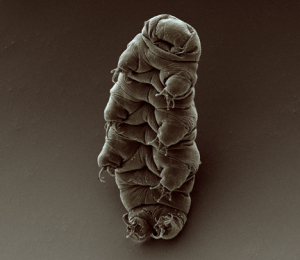Across the bay from where I live in the Bay area is a strange structure, sometimes called “the world’s safest house.” Designed by architect Eugene Tsui, this peculiar-looking and very sturdy building has been nicknamed The Fish House, but (according to Tsui) was inspired by another water-dwelling animal: the tardigrade, or water bear. Admittedly, not the most fetching of creatures, these hardy little eight-legged beasts have been of interest to scientists and even astronauts. Here’s an excerpt from The Shark’s Paintbrush section on these intriguing animals:
Is there life in space? One thing we do know, thanks to the European Space Agency, is that there are earthly life- forms that easily survive and even thrive in the extremes of space. Apart from some species of lichens and bacteria that have taken rides on space shuttles, there is at least one animal that has laid eggs 160 miles above the earth’s surface. Tardigrades (also known as waterbears, moss piglets, or their affectionate nickname, tardies) can withstand temperatures as low as minus 273° Celsius (which is minus 573° Fahrenheit and nearly absolute zero) and as high as 151° Celsius (303° Fahrenheit— one and a half times egg- cooking temperature) without a shiver or a sweat. They can live in a vacuum, liquid helium, or 90 percent alcohol and are impervious to radiation one thousand times anything that would kill us. Tardies are teetotalers, not needing water for a decade at a time. They can dry out to just 1 percent of their normal water content before their next drink— and then probably binge. Wherever you travel on this earth— from Mount Everest to Antarctica or thirteen thousand feet deep in the ocean— you can fi nd water bears. All you need is a microscope. Discovered by German scientist, Johann Goeze, in 1773, there are more than one thousand species growing to a hulking one tenth of one millimeter long (the width of a hair) and in many colors from red to green. They seem to enjoy romance, with very complicated courtship and mating rituals.
Copyright, Jay Harman. All rights reserved. Amazing little beasts.








